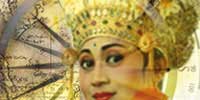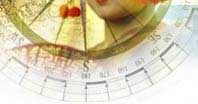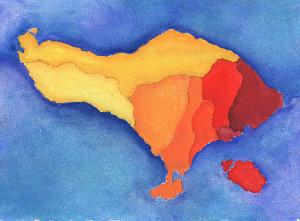Bangli
Bali houses Pura Kehen, Bali's second largest temple. The
temple has three courtyards connected by steps, and is decorated
with carvings and statues. A large banyan tree shades the
lowest and second courtyards.
Batubulan
Batubulan is home to a number of stone carvers. Divinities
and demons carved from sandstone (Paras) decorate (and protect)
houses and temples along the road that takes you from Denpasar.
Batubulan also has excellent dance and theatrical performances.
Bedugul
The mountain resort of Bedugul is well known for its golf
course and Ulun Danu, a temple which seems to rise out of
the lake to present itself beautifully. Boats, water skiing,
and parasailing are among the many watersports available
in this area.
Besakih
The sanctuary of Besakih on the slopes of Gunung Agung (Mount
Holy) is over a thousand years old and is known as the Mother
Temple of Bali, the biggest and holiest of all Balinese
temples. Steps rise through split gates to the main courtyard
where the Trinity shrines, dedicated to Shiva, Brahma, and
Wishnu, are wrapped in cloth and decorated with flower offerings.
Around them, stand eighteen separate sanctuaries, belonging
to different regencies and castes.
Celuk
Celuk is noted for silver and gold jewelry works. Their
works are extremely meticulous and detailed.
Denpasar
The capital city of the Province of Bali, Denpasar houses
government offices, banks, and many other offices. Yet it
manages to retain its Balinese personality while its temples
still mantain their presence and influence. Pura Jagatnatha,
a temple dedicated to the Sang Hyang Widi (Supreme God),
has been converted into a Musuem. The status of a turtle
and two dragons in the temple signify the foundation of
the world. The Pura's architecture resembles that of a Balinese
palace. It houses a fine variety of early and modern art.
Sanggraha Kriya Hasta is a government-supervised art center,
home to a wide variety of handicraft and works of art. Werdi
Budaya presents a yearly art festival between June and July,
with performances, exhibitions, art contest, and other artistic
activities.
Goa Gajah
Dating back to the 11th century, Goa Gajah is a cave temple
believed to be built as a monastery. Two statues flank a
demon head over the entrance, and a statue of Ganesha (Elephant)
sits inside the cave. Further excavations have uncovered
a bathing place with six statues of nymphs holding water
spouts.
Goa Lawah
Nine kilometers from Klungkung is Goa Lawah (Bat Cave).
Thousands of bats make the roof of the cave their homes.
Its entrances are guarded by a temple believed to be found
by a sage nine centuries ago.
Kintamani
The villages of Kintamani and Penelokan give a view of the
active Mount Batur and its lake. Seven miles in diameter
and sixty feet deep, the caldera of Batur is pretty impressive.
From Penelokan, a road lead to Kediasan on the shores of
the lake where boats can be rented to cross over to Trunyan.
Klungkung
The Javanese Hindu Kingdom in Bali, where Balinese royalty
draws its blood line, sat in Klungkung. It is the oldest
kingdom on the island, and its Raja the most exalted.
The ceiling of Kertha Gosa (Royal Court of Justice), built
in the 18th century, displays one of Bali's masterpieces.
Much like Michelangelo's The Creation on the Sistine Chapel,
the murals portray the punishment of hell and the rewards
of heaven, elaborated in thousands of panels of wayang style.
The floating pavillion, garden, and lotus ponds are a reminder
of the former glory of this kingdom.
Kuta
Once a lonely little village on the road from Denpasar to
Bukit Peninsula, Kuta is now the tourist mecca of Bali,
popular mainly among the young and adventurous. Coconut
trees line the sand beach as far as the eyes can see towards
the north stopped by the runway of Denpasar's airport far
in the west.The Sunset in Kuta
is most breathtaking.
Accommodations in Kuta range
from a modest homestay for a few dollars a night to luxurious,
five-star, international hotels costing several hundred
to several thousand dollars a night. The street of Legian,
situated directly behind the row of hotels that face the
beach, is lined with shops of all varieties. You can find
any Balinese handicrafts here, from the least expensive
to the most exquisite; or unique stores such as the leather
store staffed by two young Balinese men that will perfectly
sculpt for you a leather jacket. (They are all extremely
talented artists, remember?)
At night, Kuta is alive with night life. Western influences
create discotheques,
dance clubs, and pubs. Gastronomical demands inspire
a multitude of restaurants,
serving traditional Indonesian and Balinese food to various
ethnic meals from Japan, Switzerland, etc. As if these were
not enough, various Balinese dance performances are staged
in Kuta every night. One of the best Kecak performances
is to be found in Kuta.
Mas
The village of woodcarvers, Mas is still the house of Bali's
old masters. A number of art galleries exhibit some of their
best works. Mas is also known for its masks.
Menjangan Island
Located on Terima Bay, off the northwest tip of Bali, Menjangan
Island offers beautiful scenery. The water surrounding it
is known for beautiful coral reefs and its wealth of tropical
fish.
Nusa Dua
Part of the Bukut Peninsula in southern Bali, Nusa Dua has
some of the
most beautiful and luxurious hotels on this planet,
gracefully integrating the beauty of the white beaches and
clear water into the landscape of the hotels. Ronald Reagan
stayed here when he visited Bali. The beaches of Nusa Dua
allow you to gently surf along the northern side of the
peninsula. If you care for bigger waves, the southern part
of the peninsula can give you a challenge.
Peliatan
Located between Ubud and Mas, Peliatan is the center of
traditional music and dance of Bali.
Sangeh
The ten acres of nutmeg trees in the Sangeh forest are considered
sacred. Two temples stand in the middle of the forest, and
another at the edge. Monkeys heavily inhabit this forest,
and are also held sacred. They will come to you when you
visit the temples. Make sure you protect your handbags,
etc as the monkeys will steal them.
Sanur
Palm-lined beach, curving from the Grand Bali Beach Hotel
to the south and facing the Indian Ocean towards the east,
Sanur is an excellent place to see the sun rise in the morning.
I suspect this is where Nehru experienced Bali to utter
"Bali is the morning of the world." Offshore reefs protect
the beach agains the waves, and makes it popular for windsurfing,
boating, and other watersports.
Sanur is only a short distance from Denpasar, with public
transportation readily available. It is one of the first
areas where one can find good hotels,
restaurants, shops,
and other tourist facilities.
Tampak Siring
Pura Tirta Empul is the temple of Tampak Siring, built around
a sacred spring. The temple and its two bathing places have
been used by the Balinese for over 1000 years for good health
and prosperity; the spring water has curative powers. Regular
purification ceremonies take place here. Additionally, the
people of Tampak Siring produce artistic bone and ivory
carvings.
Tanah Lot
One of Bali's most important sea temples, Tanah Lot temple
is built atop a huge rock, surrounded by the sea. Build
in the 16th century, Tanah Lot's rituals include paying
of homage to the guardian spirits of the sea. Poisonous
sea snakes found in the little caves at the base of the
rocky island are believed to guard the temple from evil
spirits and intruders.
Tenganan
The village of Tenganan maintains its ancient pre-Hindu
customs through a strong code of nonfraternization with
outsiders, helped by the protection of its surrounding walls.
Unique offering ritual dances and gladiator-like battles
between youths take place. Tenganan develops a unique technique
of weaving, called the 'double ikat.' The people believe
in the magical power of the fabric.
Trunyan
Trunyan is an ancient village in Bali, inhabited by people
who call themselves "Bali Aga" or old Bali. They live in
ways that are much different from other Balinese. In Trunyan,
the temple Puser Jagat (Navel of the Universe) has an unusual
architecture and stands under a massive banyan tree. Instead
of cremating their corpses, the Bali Aga simply place them
under this banyan tree. The odor of death is mysteriously
masked by a special arboreal fragrance emitted by the banyan
tree.
Ubud
Ubud is the art center of Bali, which maybe a hard concept
to understand, given the artistic nature of the entire living
in Bali. But the Raja of Ubud, historically, strongly encouraged
artistic development, especially in painting. Ubud's Museum
"Puri Lukisan" houses a permanent collection of Balinese
paintings, dating from the turn of the century. Dutchborn
Hans Snel and American Atonio Blanco, among other internationally
prominent artists, had both called Ubud their home. The
Neka Museum is another excellent museum, with marvelous
collections of traditional Balinese paintings by local artists
as well as foreign artists who lived in Bali.
Ubud today expands to other arts. You should not be surprised
to run into a foreigner who happens to be living in Ubud,
meditating or soul searching for his next book or poetry
collection. Most hotels in Ubud are small, homely hotels
and homestays that will provide you with a room that faces
the ricefields with bird sonatas togently wake you in the
morning.
Yeh Saneh
Few people know of this idyllic spot a little further east
on the coastal road. A few meters from the splash of the
surf is a cool freshwater spring around which a large pool
and gardens have been built.
| 






